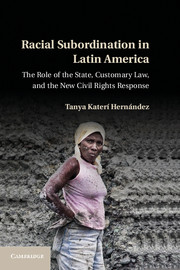The Racial Politics of Culture and Silent Racism in PeruPosted in Anthropology, Caribbean/Latin America, Media Archive, Papers/Presentations, Social Science on 2013-01-30 17:18Z by Steven |
The Racial Politics of Culture and Silent Racism in Peru
Paper prepared for the United Nations Research Institute for Social Development (UNRISD) Conference on Racism and Public Policy
Durban, South Africa
2001-09-03 through 2001-09-05
13 pages
Marisol de la Cadena, Associate Professor of Anthropology
University of California, Davis
In this talk mestizaje is both the topic and a pretext. Treating it the topic of the paper, I want to explain why, in contrast with other Latin American countries such as Mexico, Bolivia, and Ecuador mestizaje—or the project of racial mixing—never became an official national ideology in Peru. But I also want to use mestizaje as a pretext to analyse the historical production of the Peruvian culturalist scientific definition of race, which is partially similar to what analysts of contemporary European forms of discrimination have called racism without race or “new racism.” I call it silent racism, because in the case of Peru, as we shall see, culturalist forms of discrimination are neither new, nor without race. The debate about racial mixture (or mestizaje) that took place in Peru in the first half of the 20th century, is a good window to explore the reasons that Peruvian intellectuals might have had in developing this presumably peculiar definition of race which eventually allowed for the current denial of racist practices in Peru. Illustrative of these denials Jorge Basadre, one of Perus most eminent historians declared in the mid 1960s.
Historically, racism as it is understood in South Africa or in parts of the Southern United States has not existed in Peru. (…) This is not to say that there do not exist prejudices against Indians, cholos, and blacks, however these prejudices have not been sanctioned by the law and more than a profound racial feeling, they have an economic, social, and cultural character. Colour does not prevent an aborigine, mestizo, or Negroid from occupying high positions if they can accumulate wealth or achieve political success. (If there exists a distance between them and us) it is not racial, (…) rather it corresponds to what can be termed an historical state of things.
Basadre acknowledges the existance of prejudices, but acquits those prejudices of the charge of racism because they do not derive from biological race. This acquittal, which continues to characterize the Peruvian racial formation, is not a whimsical national peculairity. Rather, I argue that it is historically rooted in the scientific definition of race that Peruvian intellectuals coined at the turn of the century. Then they used it to contest European and North American racial determinisms which positioned intellectuals from my country (and Latin Americans in general) as hybrids and thus potentiallyif not actuallydegenerates. During this period Peruvian intellectuals delved into the scientific interconnection of “culture” and race,” and produced a notion of “race” through which—borrowing Robert Young’s words— “culture” was racially defined and thus historically enabled to mark differences. When, roughly in mid-century, the international community rejected race as biology, it did not question the discriminatory potential of culture, nor its power to naturalize differences. Then Peruvian intellectuals—like Basadre— dropped race from their vocabulary and criticized racism, while preserving culturalist interpretations of difference to reify social hierarchies, and to legitimate discrimination and exclusion…
Read the entire paper here.

